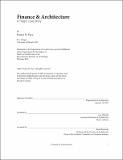| dc.contributor.advisor | Ana Miljački. | en_US |
| dc.contributor.author | Pace, Jessica N. (Jessica Nicole) | en_US |
| dc.contributor.other | Massachusetts Institute of Technology. Department of Architecture. | en_US |
| dc.coverage.spatial | n-us-ny | en_US |
| dc.date.accessioned | 2017-05-11T19:06:52Z | |
| dc.date.available | 2017-05-11T19:06:52Z | |
| dc.date.copyright | 2017 | en_US |
| dc.date.issued | 2017 | en_US |
| dc.identifier.uri | http://hdl.handle.net/1721.1/108850 | |
| dc.description | Thesis: M. Arch., Massachusetts Institute of Technology, Department of Architecture, 2017. | en_US |
| dc.description | This electronic version was submitted by the student author. The certified thesis is available in the Institute Archives and Special Collections. | en_US |
| dc.description | Page 124 blank. Cataloged from student-submitted PDF version of thesis. | en_US |
| dc.description | Includes bibliographical references (pages 122-123). | en_US |
| dc.description.abstract | Our markets are volatile. Our economy is unstable. Our future is unknown. This thesis investigates the architecture of financial institutions within in the current context of complete failure and abstraction. Historically, the building of banks was undertaken in order to produce a sense of public trust in the institution. It was the task of the architects of great financial establishments to maintain an image of lofty seclusion, of power, and of stability. They were constructed of stone, were monumental in scale and they referenced the Greek orders. Their architecture was wrought with symbolism and representation. They were built to last. However, the nature of our financial institutions have changed. The crash of 2008 represents a distinct shift in our relationship with our financial institutions. The masses began to question the interests of their government and the corruption of their financial institutions. With each new headline of scandal and fraud, public trust is no longer an option. In the face of this failure, my thesis is in search of an architecture for failure. Can architecture challenge these traditions of seclusion, power, stability and separation? Can it undermine the perception of strength that no longer defines our financial institutions? Can it acknowledge uncertainty? This thesis re-imagines the stock exchange as a machine for trading, a data center. Anticipating the total obsolescence of the trading floor, the new exchange boasts floors of servers to run the complex algorithms that will soon take over. Constantly whirring with fans and mechanical systems, the machine puts off heat which is used to inflate a network of public spaces that wind through the building. These give access and allow for new occupations of the Exchange. The new face of Wall Street is no longer solid, or stable. It is temporary, claustrophobic, flickering, buzzing and slightly saggy. | en_US |
| dc.description.statementofresponsibility | by Jessica N. Pace. | en_US |
| dc.format.extent | 124 pages | en_US |
| dc.language.iso | eng | en_US |
| dc.publisher | Massachusetts Institute of Technology | en_US |
| dc.rights | MIT theses are protected by copyright. They may be viewed, downloaded, or printed from this source but further reproduction or distribution in any format is prohibited without written permission. | en_US |
| dc.rights.uri | http://dspace.mit.edu/handle/1721.1/7582 | en_US |
| dc.subject | Architecture. | en_US |
| dc.title | Finance & architecture : a tragic love story | en_US |
| dc.title.alternative | Finance and architecture : a tragic love story | en_US |
| dc.title.alternative | Tragic love story | en_US |
| dc.type | Thesis | en_US |
| dc.description.degree | M. Arch. | en_US |
| dc.contributor.department | Massachusetts Institute of Technology. Department of Architecture | |
| dc.identifier.oclc | 986529667 | en_US |
